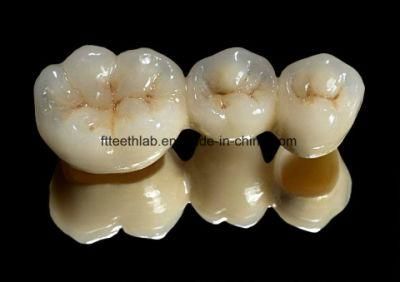
Veneered Metal Crown in Dentistry From China Dental Lab
Foo Tian Dental Lab- Logo Printing:Without Logo Printing
- Usage Times:Non-Disposable
- Kind:Metal Ceramic
- Use:Home
- Material:Metal
- Certification:CE, FDA, SGS
Base Info
- Model NO.:MC
- Shade:Different Shades as Request
- Shape:Customized
- Production Time:3 Days in Lab Production Time
- Payment Term:T,T, Paypal
- Productivity:200 Units Per Day
- Logistics:FedEx,UPS,DHL
- Warranty:2 Years
- Metal Material:Argen From The USA
- Ceramic Powder Material:Vita Vmk95
- Transport Package:Bubble Bags, Foam, Plastic Zip Bags
- Specification:metal and ceramic
- Trademark:Footian
- Origin:China
- HS Code:9021210000
- Production Capacity:200 Units,Day
Description
Basic Info.
Model NO. MC Shade Different Shades as Request Shape Customized Production Time 3 Days in Lab Production Time Payment Term T/T, Paypal Productivity 200 Units Per Day Logistics FedEx/UPS/DHL Warranty 2 Years Metal Material Argen From The USA Ceramic Powder Material Vita Vmk95 Transport Package Bubble Bags, Foam, Plastic Zip Bags Specification metal and ceramic Trademark Footian Origin China HS Code 9021210000 Production Capacity 200 Units/DayProduct Description
A crown is a type of dental restoration which completely caps or encircles a tooth or dental implant. Crowns are often needed when a large cavity threatens the ongoing health of a tooth. They are typically bonded to the tooth using a dental cement. Crowns can be made from many materials, which are usually fabricated using indirect methods. Crowns are often used to improve the strength or appearance of teeth. While inarguably beneficial to dental health, the procedure and materials can be relatively expensive.
The most common method of crowning a tooth involves using a dental impression of a prepared tooth by a dentist to fabricate the crown outside of the mouth. The crown can then be inserted at a subsequent dental appointment. Using this indirect method of tooth restoration allows use of strong restorative materials requiring time-consuming fabrication methods requiring intense heat, such ascasting metal or firing porcelain which would not be possible to complete inside the mouth. Because of the expansion properties, the relatively similar material costs, and the cosmetic benefit, many patients choose to have their crown fabricated with gold.
As new technology and materials science has evolved, computers are increasingly becoming a part of crown fabrication, such as in CAD/CAM dentistry.
